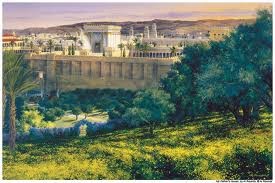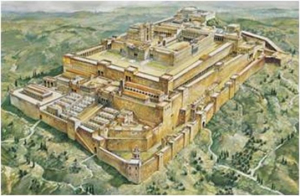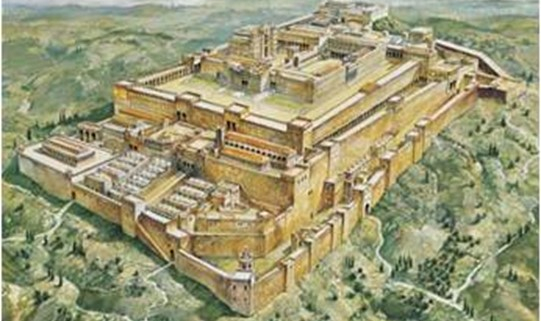My Father’s House has many Mansions
My Father’s House has many Mansions
 “In My Father’s House are Many Mansions…”
“In My Father’s House are Many Mansions…”
This is a passage of Scripture, in John chapter 14 verse 2, which causes some people to believe that Jesus was offering a place in heaven but, as Mark Buckler explains, the Lord had something quite different in mind.
Jewish Book
Many of us easily forget, when we read the Bible, that it is a Jewish book, written mainly by Jewish writers about Jewish people. It is so easy for us to read it with two thousand years of ideas and interpretations in our minds that we forget to ask a simple question:
What did the writers of this passage understand by it when they wrote it and what did their readers or hearers understand?
So, when Jesus talked about the many rooms in his Father’s house, what did he mean by this and what would his hearers have understood?
Incidentally, this is a passage that is often read in church funeral services and today it is thought to promise an inheritance with God in heaven. Is that what Jesus meant?
God’s House
The expression “My Father’s house” as used in the gospels always refers to the Temple in Jerusalem. For example, when Jesus visited the Temple as a boy of twelve, his comment to questioning parents was:
“Why were you searching for me? … Didn’t you know I had to be in my Father’s house?” (Luke 2:49).
Or when Jesus cleansed the Temple, he said: “Get these out of here! How dare you turn my Father’s house into a market!” (John 2:16).
So Jesus was saying to his disciples, in John chapter 14, that there were many dwelling places in the Temple, and that he would come back and live with them on earth in a similar way to how the priests lived close to God, because they lived in His Temple – in God’s House. But did they? Was the Temple a House for people, or just the House of God?
Temple Structure
 In the description of the building of the first Temple by Solomon, we are told of the construction of rooms built on three stories on three sides of the temple:
In the description of the building of the first Temple by Solomon, we are told of the construction of rooms built on three stories on three sides of the temple:
“Against the walls of the main hall and inner sanctuary he built a structure around the building, in which there were side rooms. The lowest floor was five cubits wide, the middle floor six cubits and the third floor seven” (1 Kings 6:5,6).
These rooms were for the Priests to live in when they were on Temple duty, so when Jesus referred to the “many rooms” in his “Father’s House”, the disciples would have been able to visualise the many rooms built on the side of the Temple, and would have understood at once what he meant.
“I will come again…” This is was what Jesus promised.
“Do not let your hearts be troubled. Trust in God; trust also in me. In my Father’s house are many rooms; if it were not so, I would have told you. I am going there to prepare a place for you. And if I go and prepare a place for you, I will come back and take you to be with me that you also may be where I am” (John 14:1-3).
He was about to die as a sacrifice for sins, but he would rise again and, in due course, would go to heaven, to sit at his Father’s right hand. But when the time is right, he will come again to earth, to live with his people – as in a temple. Were there any similar situations the disciples might think about that matched what was about to happen?
Thinking about the activities that took place in the Temple, the disciples would be reminded that daily the Priests went into the Holy Place and that once a year the High Priest went through the second veil into the Holy of Holies as the representative of the people. After making his offering he went out again to the people, having made atonement for them.
Great High Priest
Jesus was going to do the same thing for his people – but more so! He was going into the actual presence of God, not just into a representation of His presence, which was what happened in the Temple. This is a theme fully developed by the apostle Paul when writing to the Hebrews, who says:
“Christ did not enter a man-made sanctuary that was only a copy of the true one; he entered heaven itself, now to appear for us in God’s presence. Nor did he enter heaven to offer himself again and again, the way the high priest enters the Most Holy Place every year with blood that is not his own. Then Christ would have had to suffer many times since the creation of the world. But now he has appeared once for all at the end of the ages to do away with sin by the sacrifice of himself” (Hebrews 9:24-26).
In the case of Jesus, when he died God showed His total approval of his sacrifice by tearing the veil of the Temple in Jerusalem from top to bottom – to show that a new way had thus been opened into His presence, and that we are no longer dependent upon an earthly priesthood.
“Therefore, brothers, since we have confidence to enter the Most Holy Place by the blood of Jesus, by a new and living way opened for us through the curtain, that is, his body, and since we have a great priest over the house of God, let us draw near to God with a sincere heart in full assurance of faith, having our hearts sprinkled to cleanse us from a guilty conscience and having our bodies washed with pure water”
(Hebrews 10:19-22).
Again, the picture the disciples would have from words like these would be based on their own experiences of life in their times. What a different meaning we get when we look at a passage of Scripture and consider the background of the times in which it was written. If we don’t do that we are always in danger of imposing our own ideas, from later times, thus trying to make Scripture teach what we would like it to say!
By Mark Buckler
Learn here about God’s Kingdom on Earth and His House or Temple for all Nations.
![]()



